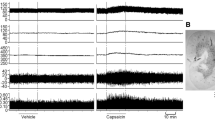Summary
(1) The influence of capsaicin-sensitive afferent neurones on the regulation of blood pressure by reflex noradrenergic responses and by activation of the renin-angiotensin system was investigated in the rat anaesthetized with pentobarbital. (2) Lowering the pressure in the carotid sinus through unilateral carotid occlusion caused a reflex rise in mean systemic blood pressure which was less marked in capsaicin-pretreated rats than in controls, although an equal drop in mean pressure in the carotid sinus region was observed in both groups. Occlusion of the second carotid artery caused an additional increase in mean systemic blood pressure which was identical in the two groups. (3) Pharmacological blockade of the renin-angiotensin-system with captopril induced a more pronounced hypotonia in capsaicin-pretreated than in control rats. Yet, this difference was based on the impaired noradrenergic counterregulation in capsaicin-pretreated rats, because both groups showed identical responses to captopril following guanethidine-induced adrenergic blockade. (4) Plasma renin activity was increased by a factor of 2 following guanethidine treatment of awake animals. It reached levels 5–7 times higher than those observed in awake animals during pentobarbital anaesthesia. This anaesthesia-induced increase in plasma renin activity was not altered by guanethidine pretreatment. There was no difference in plasma renin activity between controls and capsaicin-pretreated rats under all the conditions tested. (5) These results show that the immediate reflex adjustment of blood pressure is impaired in the capsaicin-pretreated rat, possibly because of an impairment of sensors for low perfusion pressure in the carotid sinus. On the other hand, the renin-angiotension-system remains unimpaired after neonatal capsaicin-pretreatment.
Similar content being viewed by others
References
Bond SM, Cervero F, McQueen DS (1982) Influence of neonatally administered capsaicin on baroreceptor and chemoreceptor reflexes in the adult rats. Br J Pharmacol 77:517–524
Bramhall T, Decrinis M, Donnerer J, Lembeck F (1989) Capsaicin-sensitive afferents and blood pressure regulation during pentobarbital anaesthesia in the rat. Naunyn-Schmiedeberg's Arch Pharmacol 339:584–589
Chen I, Yates RD, Hansen JT (1986) Substance P-like immunoreactivity in rat and cat carotid bodies: light and electron microscopic studies. Histol Histopathol 1:203–212
Donnerer J (1988) Reflex activation of the adrenal medulla during hypoglycemia and circulatory dysregulations is regulated by capsaicin-sensitive afferents. Naunyn-Schmiedeberg's Arch Pharmacol 338:282–286
Furness JB, Elliott JM, Murphy R, Costa M, Chalmers JP (1982) Baroreceptor reflexes in conscious guinea-pigs are unaffected by depletion of cardiovascular substance P nerves. Neurosci Lett 32:285–290
Gamse R (1982) Capsaicin and nociception in the rat and mouse. Possible role of substance P. Naunyn-Schmiedeberg's Arch Pharmacol 320:205–216
Helke CJ, Hill KM (1988) Immunohistochemical study of neuropeptides in vagal and glossopharyngeal afferent neurons in the rat. Neuroscience 26:539–551
Hubbard JW, Buchholz RA, Reed K, Nathan MA, Keeton TK (1988) Changes in plasma catecholamines and plasma renin activity during hypotension in conscious rats with lesions of the nucleus tractus solitarii. J Autonom Nerv Syst 22:97–106
Keeton TK, Campbell WB (1981) The pharmacologic alteration of renin release. Pharmacol Rev 31:81–227
Kummer W (1988) Retrograde neuronal labelling and double-staining immunohistochemistry of tachykinin- and calcitonin generelated peptide-immunoreactive pathways in the carotid sinus nerve of the guinea pig. J Autonom Nerv Syst 23:131–141
Lembeck F (1987) A network of defense. In: Henry JL, Couture R, Cuello AC, Pelletier G, Quirion R, Regoli D (eds) Substance P and Neurokinins. Springer, Berlin Heidelberg New York Tokyo, pp 380–387
Lembeck F (1988) The 1988 Ulf von Euler Lecture. Substance P: From extract to excitement. Acta Physiol Scand 133:435–454
Lembeck F, Donnerer J (1983) Reflex fall in blood pressure mediated by capsaicin-sensitive afferent fibers of the rat splanchnic nerve. Naunyn-Schmiedeberg's Arch Pharmacol 322:286–289
Takano Y, Nagashima A, Kamiya H, Kurosawa M, Sato A (1988) Well-maintained reflex responses of sympathetic nerve activity to stimulation of baroreceptor, chemoreceptor and cutaneous mechanoreceptors in neonatal capsaicin-treated rats. Brain Res 445:188
Udelsman R, Norton JA, Jelenich SE, Goldstein DS, Linehan WM, Loriaux DL, Chrousos GP (1987) Responses of the hypothalamic-pituitary-adrenal and renin-angiotensin axes and the sympathetic system during controlled surgical and anesthetic stress. J Clin Endocrinol Metab 64:986–994
Author information
Authors and Affiliations
Additional information
Send offprint requests to J. Donnerer at the above address
Rights and permissions
About this article
Cite this article
Donnerer, J., Schuligoi, R. & Lembeck, F. Influence of capsaicin-induced denervation on neurogenic and humoral control of arterial pressure. Naunyn-Schmiedeberg's Arch Pharmacol 340, 740–743 (1989). https://doi.org/10.1007/BF00169683
Received:
Accepted:
Issue Date:
DOI: https://doi.org/10.1007/BF00169683




